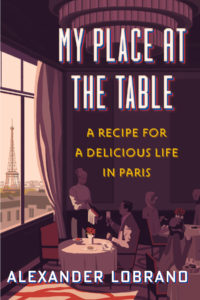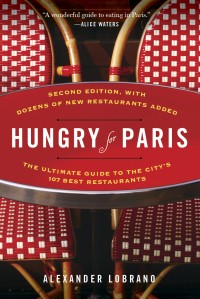Shu–brilliant Japanese food in St. Germain des Pres: A-; and the future of Paris Markets
Paris falls narcissistically in love with Japan every couple of generations for obvious reasons. Parisians love the importance that the Japanese attach to the aesthetics of daily life, their love of ritual, and their extremely good manners. Sometimes these recurring crushes focus on art, like the Japanese screens and ceramics that inspired many Impressionist painters, but this time round, its Japanese food that’s the object of Parisian affections. Seriously good Japanese restaurants are opening all over the city, and many of the city’s best young bistro chefs freely avail themselves of the Japanese pantry (wasabi, yuzu, miso, soy, etc.) and cooking techniques like tempura and steaming.
When I first moved to the city in 1986, there was a good sushi bar in the rue des Ciseaux in the 6th, and a couple of Japanese places in and around the rue Saint Anne, plus a scattering of mediocre and possibly dangerous sushi-and-tempura joints in the Latin Quarter. Now almost every Paris neighborhood has at least one serious Japanese restaurant and sushi has become a common takeout item. The Parisian love of Japanese good is galloping this Fall, too, with a bunch of new openings. My favorite, however, is Shu, which opened a year ago in a tiny backstreet in Saint Germain and has quickly developed an almost cult-like following for the exquisite tasting menus of very talented and charming young chef Osamu Ukai.
A week after I last managed to get through the door–anyone but a dwarf will be bent over almost double getting through the miniature front door that leads down to this cosy and very pretty basement restaurant, I’m still thinking about how delicious the food was an yearning for more. Our meal began with a tiny ball of chopped squid with spinach and mushrooms—a sublime expression of all these ingredients, then some of the best sashimi I’ve ever had (sea bream with lychees); flash-grilled tuna and eggplant in sesame sauce; veal tongue marinated in miso with broccoli; sea bass carmelized in Balsamic vinegar; and finally a wonderful assortment of kushiage, or breaded, deep-fried bites of quail’s egg, chicken, eggplant, shitake mushroom with shrimp, and crab and patty pan squash on bamboo skewers. Japanese desserts usually leave me cold–I find them too sweet, but Ukai’s green-tea cheese cake was bliss. The wine list here is extremely well thought out–we drank a white Menetou Salon with our meal, and it flattered every dish, and they also have a great choice of sakes.
Shu, 8 rue Suger, 6th, Tel. 01-46-34-25-88, Metro: Saint-Michel or Odéon. Avg 50 Euros.
——-
Several recent events have made me aware of how lamentably little Paris does to promote itself as the world capital of gastronomy. Attending the first Gastronomare festival in Marseille last weekend, I was impressed by the organization and carefully considered intentions of this event, which seeks to promote a great knowledge and understanding of the culinary culture of the Mediterranean world.
Of particular interest was a colloqium on the state of traditional urban food markets in various Mediterranean destinations, including Turkey, Turin, Provence and Barcelona. Suffice it to say that all of these very different places are undertaking major efforts to protect, promote and modernize their urban food markets. If only the same were true in Paris! To be sure, Paris has several fine food markets, both in covered halls and open-air, but I have no sense that the city prizes its markets as vital components of economically prosperous, socially diverse city neighborhoods. Through the years, Paris has allowed several famous covered markets to die—Les Halles, bien sur, but also La Place du Marche Saint Honore, or sadly wither, the Marche du Saint Germain des Pres. Many other markets are decidedly senile, the Marche de l’Europe in the 8th being a melancholy example of one that’s just fading away. Market streets die out, too—the rue du Buci in the 6th is the saddest example, and the explanation for this situation is the ongoing gentrification of central Paris with the implicit complicity of City Hall. Many of the covered markets that have died out were later reclaimed and redeveloped as expensive retail or office space, and it’s shocking that none of the possible redesign projects for Les Halles include a food market—if only a party of municipal notables would visit Barcelona’s brilliant Santa Caterina or Barceloneta markets to see how a market can play a staring role in animating a city neighborhood.
The other serious problem in Paris is that it’s lost its agricultural hinterland. With the exception of a few farmer producers like Joel Thiebault, agriculture in the Ile de France has almost completely died out, with the result that much of what’s sold in Parisian markets is purchased wholesale at Rungis and then resold at a mark-up the more picturesque settings of Parisian markets. I can’t help thinking, however, that if New York was able to renew its market culture almost from scratch through the city’s green-market program (these markets sell seasonal produce grown almost within the radius of a two-hour drive from Manhattan in any direction), Paris could too. It’s simply a question of supply and demand. So let’s be demanding.




